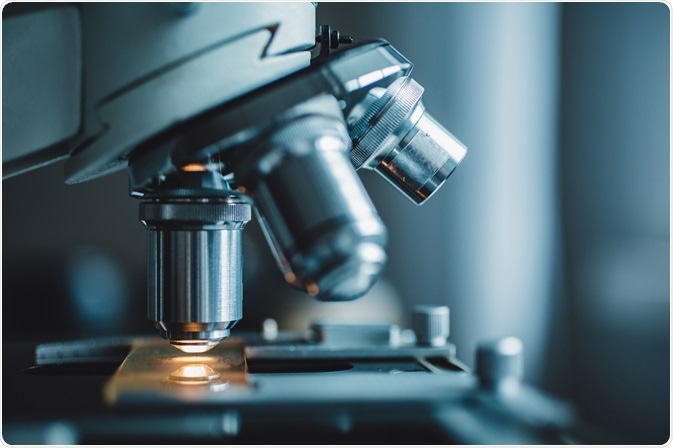Optical microscopy, a method by which images of small objects can be acquired and visualized at very high resolutions via light, has undoubtedly allowed for the advancement of biological research.
Features of optical microscopy such as the ability to mark structures, specific proteins, and organelles through the use of fluorescent probes make optical microscopy techniques ideal for experimental purposes.
Essentially, optical microscopy can broadly be categorized into fluorescence and brightfield microscopy, each with their own experimental capabilities, that ultimately allow the detailed visualization of cellular components. This article provides an overview of widely used optical microscopy techniques and their use in research.

Microscope. Image Credit: Konstantin Kolosov/Shutterstock.com
Fluorescence Microscopy
Fluorescence microscopy is an optical microscopy technique that uses fluorescent dye molecules, which are known as fluorophores, that absorb a particular wavelength of light. This absorption wavelength is referred to as the excitation wavelength. These fluorophores then emit light at a longer wavelength than the excitation wavelength and this is referred to as the emission wavelength.
Typically, a sample of interest is labeled with specific fluorophores and a higher energy source is used to illuminate the target sample. This causes the fluorophores to absorb light (excitation wavelength) and emit light at a longer wavelength of light (emission wavelength). Fluorescence filters in the microscope allow this fluorescent light to be distinguished from surrounding interfering light and so enable the cells or proteins that are marked with fluorophores to be visualized.
In comparison to a conventional brightfield light microscope which uses wavelengths of light in the visible range to illuminate and magnify an object or sample, fluorescence microscopy utilizes a much higher energy source to excite the fluorophores tagged to a sample of interest. This, therefore, enables detailed features of small samples to be visualized.
Additionally, fluorescence microscopy has improved resolution when compared to brightfield microscopy. This is because the images acquired from brightfield microscopy are reliant on different areas of a sample having different densities and therefore resulting in corresponding absorption variations of light.
However, this can result in poor contrast of structures within cells and the inability to study the detailed structures of cells when compared with fluorescence microscopy.
Epifluorescence Microscopes
Components of a microscope that are essential for fluorescence imaging include a light source, a filter for the light that is incoming, a filter for the light that is emitted, a dichroic beam splitter, and a camera to both detect the light and view the image. These essential components are contained within several microscopes; however, epifluorescence microscopes are the most typically used for fluorescence imaging.
The excitation light which illuminates the sample travels through the same objective as the emission light path in epifluorescence microscopes.
Confocal Microscopy
A major limitation attributed to epifluorescence microscopes is that there can be out of focus light which can potentially obscure the images of cells or structures that are trying to be acquired. This is because the detecting camera cannot distinguish the light from within the focal plane and outside of the focal plane.
Confocal microscopy is an optical microscopy technique that eliminates this limitation of epifluorescence microscopes. With confocal microscopy, a laser beam is utilized to illuminate one single precise point in the focal plane. The incorporation of a pinhole in confocal microscopes means that only light emitted from the single point in the focal plane is allowed to travel through the pinhole and subsequently be detected by the detector.
Thus, overall giving an image that does not contain out of focus light from outside the focal plane as with epifluorescence microscopes.
Lightsheet Microscopy
Light-sheet microscopy has been a further technique that has greatly advanced the area of optical microscopy and its application for research purposes. Images are acquired from light-sheet microscopes by illuminating a sample of interest from a plane that is at a right angle to the imaging plane. This feature again eliminates the problem of out of focus light encountered in optical microscopy as only light from within the focal plane and extending to some light which is close to the focal plane is excited and therefore detected.
This also has advantages for live cell imaging as the limited exposure to light reduced complications such as photobleaching and phototoxicity. This is important as these associated problems of optical microscopy techniques can limit research findings, particularly with regards to therapeutics.
Conclusion
Overall, optical microscopy is an immensely wide field that is continually expanding with more and more advanced techniques emerging which provide improved resolution and quality of acquired images. Therefore. it is necessary to choose the correct optical microscopy technique for specific experiments that will be best suited for your experimental design.
For this reason, it is important to consider the advantages and disadvantages of various optical microscopy techniques as well as the features of the sample of interest that will be investigated.
References:
- Murphy DB, Davidson MW (2012). Fundamentals of Light Microscopy and Electronic Imaging, Hoboken, NJ: John Wiley & Sons.
- Inoué S (2006). Foundations of confocal scanned imaging in light microscopy. In: Handbook of Biological Confocal Microscopy, ed. JB Pawley, New York: Springer, 1–19.
- Stelzer EHK (2006). The intermediate optical system of laser-scanning confocal microscopes. In: Handbook of Biological Confocal Microscopy, ed. JB Pawley, New York: Springer, 207–220.
- Wu Y, Wawrzusin P, Senseney J, Fischer RS, Christensen R, Santella A, York AG, Winter PW, Waterman CM, Bao Z, et al. (2013). Spatially isotropic four-dimensional imaging with dual-view plane illumination microscopy. Nat Biotechnol 31, 1032–1038.
Further Reading
Last Updated: Jan 11, 2021